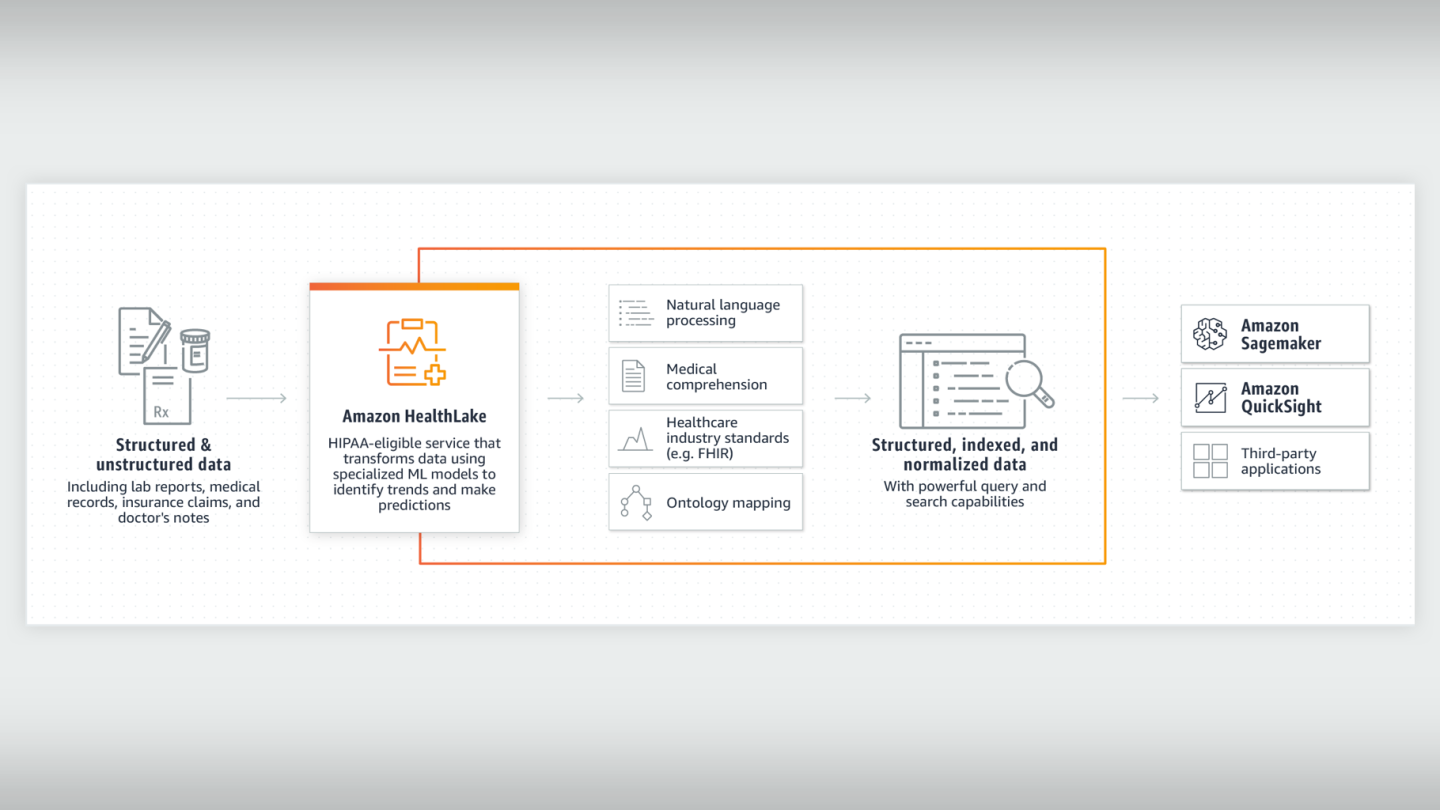During yesterday's re:Invent 2020 Machine Learning keynote, Matt Wood, AWS vice president of AI, announced Amazon HealthLake, a HIPAA-eligible service that enables healthcare providers, health insurance companies, and pharmaceutical companies to store, transform, query, and analyze health data in the cloud at petabyte scale.

The new service provides these customers with the ability to use machine learning to spot trends and anomalies in health data so they can provide more precise care for individual patients and across entire populations.
One of the scientists behind the new service is Taha Kass-Hout, MD, MS, AWS director of machine learning. A physician and bioinformatician, Kass-Hout has developed a successful track record in the past two decades innovating on behalf of customers, and pioneering in healthcare and life sciences, precision medicine, and artificial intelligence. Prior to joining Amazon in 2017, he was the first chief health informatics officer for the US Food and Drug Administration (FDA), where he created openFDA and precisionFDA, part of President Obama’s 2015 Precision Medicine Initiative. Previously, he served as director of health informatics solutions and operations for the US Centers for Disease Control and Prevention (CDC).
Prior to the announcement, Kass-Hout took some time to answer questions about the new service for Amazon Science.
Q. There’s a desire for our health care system to shift from reactive to proactive, to provide more preventative care. What role can Amazon HealthLake play in accelerating that trend?
First, Amazon HealthLake is a HIPAA-eligible service that allows our healthcare and life sciences customers to bring together their disparate health information previously stored in many different formats, and within various data silos, into a secure data lake they own and control. Emerging open standards, such as the Fast Healthcare Interoperability Resources (FHIR), aim to address this challenge by providing a consistent format to describe and exchange structured data across these systems.
However, much of this data is unstructured information, like clinical notes, PDF laboratory reports, insurance claims, X-ray and MRI images, recorded conversations, heart ECG or brain EEG traces, and more, which means the data needs to be extracted and transformed before it can be searched and analyzed. Amazon HealthLake ingests data in FHIR V4 format and then normalizes this information and tags the dates and any key descriptions of events, such as medications, procedures, diagnoses, across every encounter a patient might have throughout their health history. It then indexes all the information so it can be searched later. Now, you have a complete view of an individual patient’s history that is to a level of granularity where now you can apply advanced analytics or predict a bunch of interesting things with new machine learning models to all that data, not just a subset of it.
Amazon unveils Amazon HealthLake, big data store for life sciences https://t.co/IBOlEje6Yy
— ZDNet (@ZDNet) December 9, 2020
For example, today the most widely used clinical models to predict someone’s risk of disease oftentimes might have as few as 20 or 30 data points, like someone’s risk of a heart attack or failure. However, if you look at an individual's medical record, there may be at least 250,000 to 300,000 data points, including their medical notes. None of this is used today to manage patients or predict their outcomes. So, we believe the ability to read someone’s entire medical history will lead to better clinical decisions where health care providers can now discover trends and insights on their entire populations from this previously untapped information.
Q. What is the secret sauce of Amazon HealthLake?
At a high level, it’s the ability to create a comprehensive data set in a secure data lake that can be organized by different attributes, and then queried and analyzed with advanced analytics and machine learning. This ability to search and apply advanced analytics, or predict potential disease outcomes with machine learning models, including healthcare utilization metrics, or cost, is very powerful.
The benefit is that now you can make predictions much earlier than you could previously, or intervene quickly to improve care and reduce cost. The other benefit is now you have access to all this information through a standards-based API, allowing you — with the patient’s consent — to share that data between health systems and with popular third-party applications, analytic platforms, etc. Providers can collaborate more effectively and patients can have unfettered access to their medical information. Using Amazon HealthLake, you now have a patient’s entire medical information structured and organized with a timeline, allowing you to run numerous models to assess risk of chronic disease, manage total medical expense, or predict a patient being readmitted to a hospital after being discharged—at an individual level as well as the population level.
Q. If you were still a practicing physician today, what would most excite you about this solution?
What excites me most is that at the point of care physicians can now look at the individual in front of them and determine what's relevant at that time for each individual patient. They can also zoom out to look at the entire population, compare and manage the broader population with data-driven decisions. This will enable a higher quality of patient care, as physicians can use data to figure out what is working and what is not.
Imagine you have a diabetic patient whose condition you’re managing, and two months later their A1C or glucose level is still not responding to the treatment that you have prescribed. Imagine that you can have comparative analysis on that patient and figure out what other individuals might be similarly unique, and see what worked, or didn’t work for them. Now that you have this comprehensive information available to you about the patient, as well as the entire population, you can make point-of-care decisions that are driven by evidence from the overall data. That’s something really profound. It’s something that’s desperately needed to close gaps in care and ensure you’re providing the highest-quality care every patient deserves, and find out what is working and what isn’t for the larger population.
Q. If Amazon HealthLake had been available a decade ago when you were at the CDC and FDA, how might that have changed your approach to those roles?
No doubt we would have been able to find aberrations from the norm in the larger population much earlier. We could have done far more predictive analytics and figured out sooner whether interventions were working or not, for example, during the H1N1 pandemic I worked on. Having that ability to look across all information and then glean insights from the data, whether it was about an emerging outbreak, or evaluating certain conditions propagating within a community, and then identifying gaps in care, or what might have contributed to disparities in disease susceptibility, would have been immensely helpful.
At the FDA, the amount of information you're trying to manage is enormous. For example, take post-marketing surveillance. This is when a new drug is being approved and you're trying to track across the population to determine if there are any adverse reactions, or trying to understand why a certain part of the population is responding positively, while another isn’t. Oftentimes in these situations we struggled dealing with a lot of unstructured data that comes through in all forms, whether it’s a patient reporting information, or a physician, a pharmacist, or data that a pharma company is mandated to submit.
One of the greatest things about Amazon Web Services is not only are we removing the heavy lifting for all these components, but demystifying machine learning and artificial intelligence.
Data is often unstructured like a handwritten note, containing typos, abbreviations, and spelling errors. There are a lot of lost signals in that large volume of text that a solution like Amazon HealthLake absolutely would help identify. That’s because Amazon HealthLake takes the meaning and context into account to extract and establish relationships between entities, such as a medication and its dosage for a medical condition and the associated adverse reaction. It would provide that opportunity to find a needle in a haystack, and provide earlier detection of any adverse events from the wide variety of unstructured medical data that's been collected.
If all of those tools were available 10 years ago, I could have imagined getting ahead of outbreaks or disease propagation in any community, and understanding the complexities associated with each occurrence. We then could have applied a combination of modeling and pattern recognition so we could deliver better outcomes for the public.
Q. Is the development of a service like Amazon HealthLake one of the reasons you decided to join Amazon four years ago?
Absolutely. I have been on a mission focused on making more informed health decisions, whether that’s at the point of care, or as a public health official trying to determine the right public health intervention at the population level. It is humbling to be part of the team building tools and machinery to help healthcare providers, public health officials and others carry out their missions securely, and at scale with the most advanced and accurate scientific tools. The democratization of these technologies so a clinician like myself can use these tools regardless of technical depth is of immense value.
One of the greatest things about Amazon Web Services is not only are we removing the heavy lifting for all these components, but demystifying machine learning and artificial intelligence. We are simplifying access to these tools so they can be plugged in and tailored to individual needs, whether you are at the bottom of the stack — someone with deep expertise —or a novice practitioner. The power of Amazon HealthLake is that you can bring all your data together in a secure environment that only you can access, and then derive trends, insights, and findings from all your data to make clinical decisions, recommendations, and perhaps new policies. That is the promise of a learning health system.





